© 2011 Eric Muehlthaler and
Bob Hackett
SENSUIKAN!
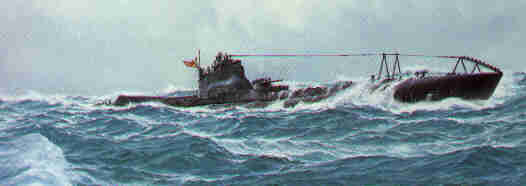 Midget Submarine at Halmahera Island, Moluccas,
Midget Submarine at Halmahera Island, Moluccas,
Netherlands East Indies -1944
29 March 1942:
Japanese forces land at Halmahera and occupy the island in the third phase of their 1st Stage war strategy. In the following years, the Japanese
construct airfields and Kau becomes an important naval port.
January 1944:
The Japanese begin developing Halmahera as a focal point for the defense of the southern approaches to the Philippines. Initially, it is planned to send two midget submarines to Halmahera Island in the Moluccas for defense against an enemy invasion.
May 1944:
LtGen Ishii Yoshiho's 32nd Division arrives at Halmahera to defend the island and its nine airstrips.
The Japanese expect that an invasion of Halmahera is imminent. The 26th Special Base Force's CO, Vice Admiral Ichinose Shinichi,
intends to wage an all-out battle against the Allied fleet, using all available resources for a Tarawa-style “waterfront repulse.”
27 May 1944:
Ourazaki, south of Kure. Japan. Auxiliary transport (ex-auxiliary gunboat) TOSHO MARU (1,289 grt) departs from the ”P-Base”, on the NE tip of Kurahashi-Jima, for the Netherlands East Indies towing HA-58, a Type C Hei-gata midget submarine. The 46-ton midget is towed because it is too heavy to be handled by the ships' derricks.
HA-58 is commanded by Lt (j.g.) Otomo Hiroshi (70)(former CO of HA-50). His crewmen are Chief Petty Officer Yamamoto Katsunosuke and Chief Machinist Utsumi Yoshiaki. For the long voyage, her three-man crew and four maintenance personnel are embarked on TOSHO MARU. Most probably, some or all of HA-58's crewmen are rotated aboard the midget submarine to maintain steering control and avoid a collision with TOSHO MARU. [1]
Initially, it is planned to send a total of six midget submarines to Halmahera Island in the Moluccas for defense against an enemy invasion.
Ultimately, HA-58 is the only boat to arrive there. [2]
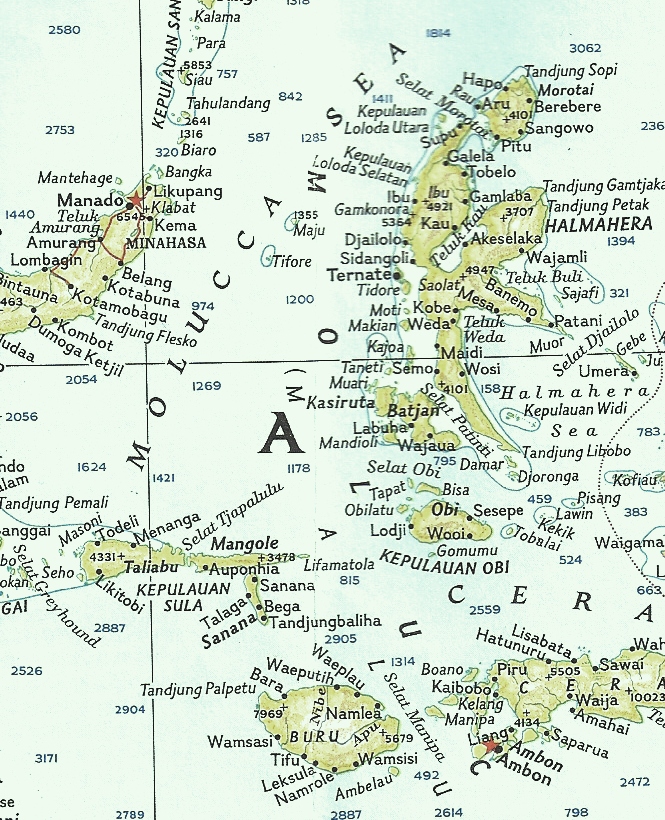
Molucca Sea showing Halmahera, Morotai and nearby Ambon and Manado, NEI ports
2 June 1944:
TOSHO MARU departs Mutsure-Jima and sails independently
southward along the west coast of Kyushu. She calls at Kagoshima, Koniya,
Sesoko, Naha and Ishigaki-Jima.
13 June 1944:
TOSHO MARU and HA-58 arrive at Kirun (Keelung) where TOSHO MARU replenishes coal and fresh water.
15 June 1944:
The pair departs Kirun.
16 June 1944:
TOSHO MARU and HA-58 arrive at Takao where TOSHO MARU
again replenishes coal and loads farm implements.
18 June 1944:
The pair departs Takao.
23 June 1944:
TOSHO MARU and HA-58 arrive at Manila. TOSHO MARU
discharges postal cargo, loads firearms and provisions and embarks passengers.
HA-58 is taken to Cavite Navy Yard, operated by the IJN’s 103rd Repair and
Contruction Unit. The midget submarine enters dock and undergoes maintenance and
repairs.
2 July 1944:
TOSHO MARU, again towing HA-58, departs Manila southward
in a convoy with three unidentified transports.
14 July 1944:
TOSHO MARU and HA-58 arrive at at the northern entrance
to Kaoe Bay, Halmahera, Moluccas, Netherlands East Indies. [3]
TOSHO MARU’s captain is informed of mines laid nearby and has to stop. The midget submarine surfaces. A patrolling IJA aircraft
spots HA-58, mistakes her for an enemy submarine and drops bombs. Luckily,
HA-58 is only slightly damaged.
Later that same day, TOSHO MARU and HA-58 arrive off Malifoet villages, Bocht van Loleo lamo (Loleo lamo Bay), on the inner part of Kaoe Bay about 4 miles SW of Kaoe village. 28 passengers disembark.
15 July 1944:
TOSHO MARU lands 27 passengers, arms, torpedoes, ammunition, small type mines, machine guns and provisions.
After arrival, HA-58 is attached to the local 26th Special Base Force. A
search begins for a suitable site to build an operational midget submarine base.
Finally, a site is found at the inner part of Kaoe Bay near Tanjoeng Loleo at
01-08N, 127-49E. [4]
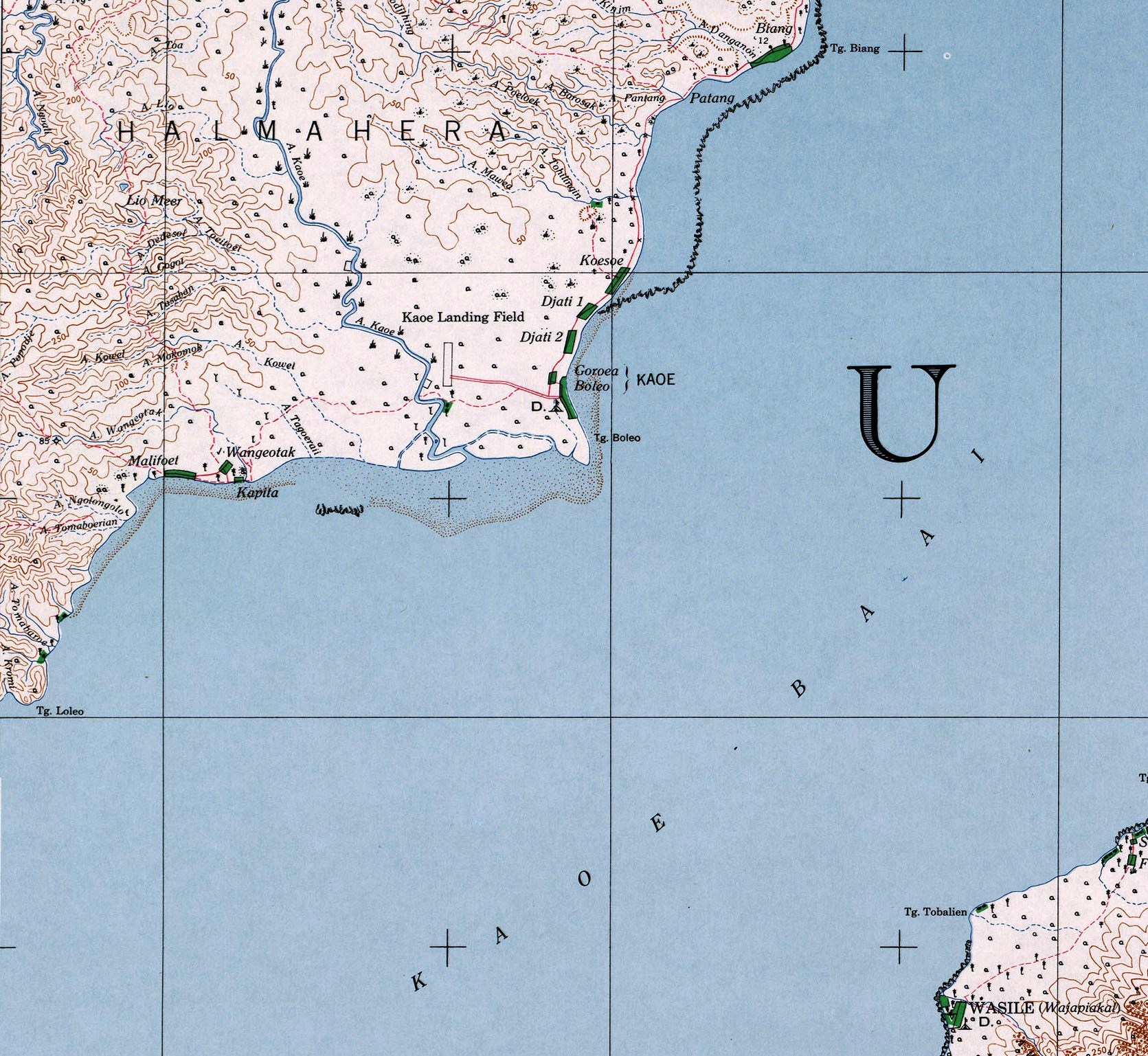
Kaoe Bay also showing Malifoet, Tanjoeng Loeleo and Tanjoeng Boleo.
The mouth of a nearby jungle river is selected for a provisional
operation base. According to a 1943,contemporary Notice to Pilots, a steamboat
can enter the river at high water. The Malifoet villages are located very close
to the Kaoe River. [5]
A construction unit stationed nearby is ordered to build provisional base
facilities for HA-58 near the river’s mouth. Within two days, the unit builds a
small wooden wharf, barracks, generating station and strings a telephone line.
To conceal the midget submarine from enemy patrol planes, a winch is
installed to to haul HA-58 up onto the sand beach alongside the wharf during
high tides. To conceal the deforestation, cut down trees and foliage are placed
in and around the camp. Later, efforts to haul the submarine up are reduced and
the midget is simply bottomed near the beach.
Technical support is almost non-existent for this tiny base and it becomes more and more difficult to keep HA-58 operable. Allied air activity
steadily increases.
12 September 1944:
Halmahera. Sixteen North American B-25J “Mitchell” medium bombers of the 38th Bomb Group’s 71st, 822nd and 823rd Bomb Squadrons based at Borokoe Airfield, Biak, Papua, New Guinea conduct a low level bombing mission on the Kaoe area.
The 16 B-25s arrive in three flights, each in line abreast formation. Each flight strafes a different township and drops parachute bombs with 8-11 second delay fuses. Altogether, the planes drop 192 bombs and expend 33,300 rounds of .50 cal ammunition in or near the area of the midget submarine base.
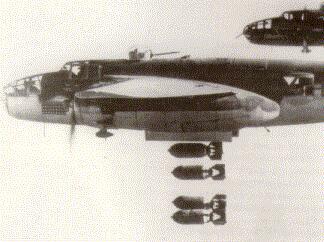
North American B-25
During the attacks, HA-58 sustains damages, but it is impossible to know which flight actually hit the midget submarine. Because local capabilities are very limited, HA-58's damages cannot be repaired.
15 September 1944: Operation TRADE WIND:
Morotai Island. Rear Admiral (later Vice Admiral) Daniel E. Barbey's (USNA '12) Task Force 77 supported by two heavy and three light cruisers and ten destroyers and aircraft from six escort carriers lands MajGen John C. Persons' 41st Infantry (Reinforced). Task Force 77 carries 40,000 American soldiers. Morotai is defended by only about 500 Japanese.
Morotai’s interior has no military value, so the Allies do not advance beyond a perimeter needed to defend the airfields. Later, Japanese airfield facilities on Morotai are improved by the Allies and used for operations against the Japanese in the Philippines. Intermittent fighting continues on Morotai until the end of the war. The Japanese troops suffer heavy losses from disease and starvation. Nearby but heavily defended Halmahera Island is by-passed.
21 September 1944:
Near Kaoe Bay, Halmahera. Seven North American B-25J “Mitchell” medium bombers of the 42nd Bomb Group’s 69th Bomb Squadron based at Middleburg Airfield (a.k.a Klenso or Toem Airfield), Papua, New Guinea (West Irian Jaya) conduct a barge-sweep of Halmahera.
Led by Lt Donald Halloway, the B-25s strafe a long fuel barge and a two-man submarine. The planes fire 1650 rounds and score a direct and two near misses with 100-lb bombs on the barge and two near misses on the midget submarine, almost certainly the already damaged HA-58.
HA-58 is unable to submerge. It is just a question of time until the crippled midget submarine is caught by harassing USN PT-boats. A decision is made to tow the inoperable submarine into the bay and scuttle her.
Later, HA-58's crew and maintenance personnel are reassigned to the 26th Special Base Force's 3rd Battalion. HA-58’s former CO,
Lt Otomo, is now the battalion commander.
15 August 1945:
Hositilities between Japan and the Allies Forces cease.
26 August 1945:
The U.S. 93rd Division accepts the surrender of 40,000 by-passed Japanese troops at Halmahera after the Japanese commander is brought to Morotai on a
USN PT boat.
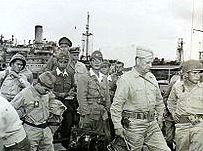
Halmahera Surrender Party arrives at Morotai
Authors’ Notes:
[1] On 11 Jan ‘44, Lt Otomo set out from Saeki for Palau with his Type A midget submarine HA-50 towed by fleet tanker YAMAZURU MARU (2, 651 grt) in convoy O-105, but on 14 Jan ‘44, LtCdr (later Cdr) Royce L. Gross’ (USNA ’30) USS SEAWOLF (SS-197) torpedoed and sank YAMAZURU MARU and HA-50 about 300 miles NE of Okinawa. Lt Otomo was among the survivors, but 36 men were KIA.
[2] Another Japanese source gives the number of midget submarines to be sent Halmahera as six.
[3] Another source gives the date as 21 Jul ’44.
[4] It seems no one had either been informed of the arrival of HA-58, or expected her safe arrival after such a long and dangerous voyage, as the search for a suitable base started only after her arrival.
[5] Though not explicitly named, the only suitable river in the vicinity of Tanjoeng (Cape) Loleo is the Kaoe River at 01-09N, 127-51E.
Thanks go to Sander Kingsepp of Estonia, Luke G. A. Ruffato of Italy and Gilbert Casse of France.
-Eric Muehlthaler and Bob Hackett
Back to Submarine
Page









